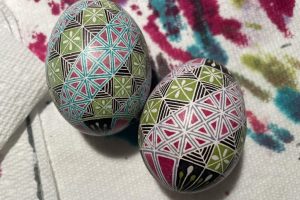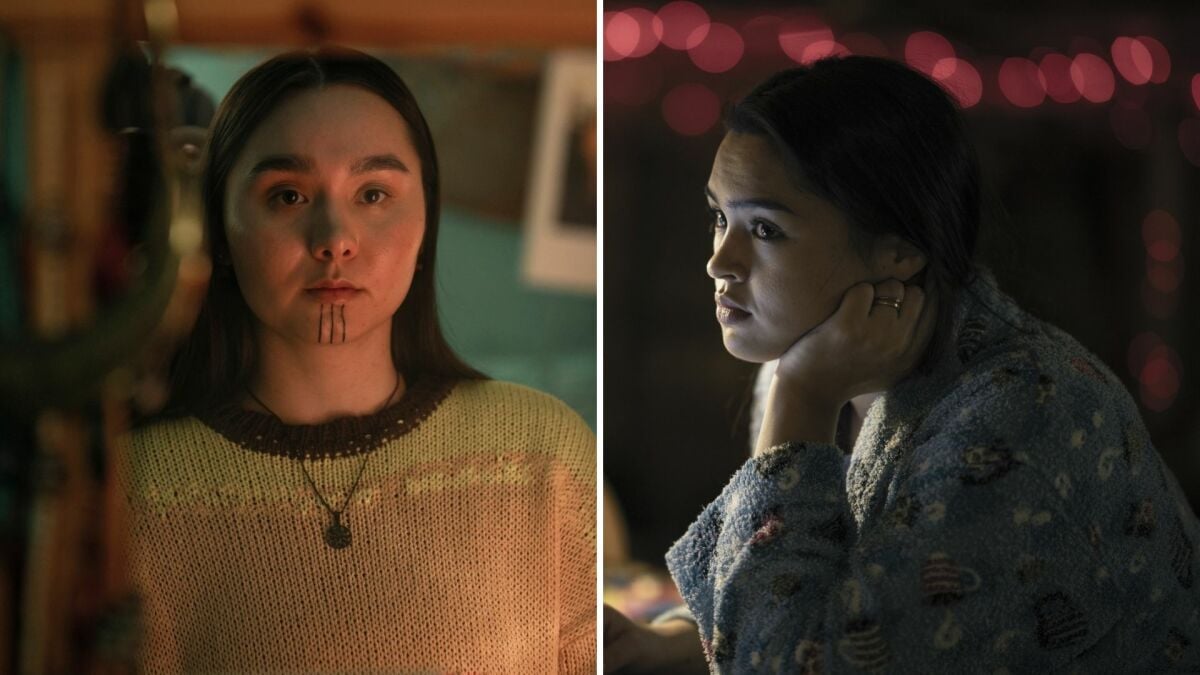In True Detective: Night Country, the rift is growing between Chief Liz Danvers (Jodie Foster) and her stepdaughter Leah (Isabella Star LaBlanc). In episode 1, the pair argued over a video the teen made with her girlfriend. Then, episode 2 brought an explosive argument over a traditional chin tattoo, which brought Kayla Prior (Anna Lambe) and her grandmother (Doreen Nutaaq Simmonds) into the fray. In the third episode, Danvers pushes this fight further, forcing Leah to wipe the temporary tattoo off her chin. More than a battle between mother and child or different generations, this is a white woman in authority literally wiping away the culture of Iñupiaq people, of which Leah and Kayla are a part. Where can these women go from here?
Mashable sat down with Indigenous actresses Isabella Star LaBlanc and Anna Lambe to talk about this conflict in True Detective: Night Country. The conversation expanded into what it was like working with Jodie Foster and how writer/director Issa López relied on guidance from producers Princess Daazhraii Johnson and Cathy Tagnak Rexford, who convened a counsel of Iñupiaq women to offer guidance as the series took shape.
What does the chin tattoo in True Detective: Night Country mean?
As Leah, Isabella Star LaBlanc regards her temporary chin tattoo in “True Detective: Night Country.”
Credit: Michele K. Short / HBO
For LaBlanc, the vertical lines drawn on Leah’s chin “means so much personally about how she sees herself and what matters to her.” The actress added, “But I think it’s also just an amazing way for her to feel connected to these people, to Kayla, to her grandma, and to feel like she has a place and purpose and people that care about her. It’s a very strong symbol of connection to her.”
Leah’s dad died years before, leaving her in Danvers’s care. “They’re the only family they have,” LaBlanc said of the strained mother-daughter bond. “I see their relationship as two people who are always missing each other. They’re just totally on different pages at all times. And they have a lot of love for each other, but they can’t seem to say that or see that in each other.”
However, in Kayla’s home, which she shares with husband Peter (Finn Bennett) and son Darwin (Xavier Osmanson), Leah is embraced with affection and instruction on her Iñupiaq heritage, including the temporary chin tattoo. Speaking to the argument over the ink in episode 2, Lambe noted Kayla was raised close to Iñupiaq culture through her grandmother’s care. So, for Danvers to come into their home, “a safe space for a young person to reconnect and to grow,” and aggressively reject this cultural tradition is unacceptable. “Danvers is not only disrespectful to her family and to Kayla in general, but to the Iñupiaq as a whole,” Lambe said. “It is so offensive, and it definitely just further drives the wedge between them.”
There’s a sense in the series Danvers is trying to use her white privilege to protect her stepdaughter from the fate of Annie K, as episode three cuts from Leah wiping away the tattoo to Danvers looking over post-mortem photos of Annie K — who has a chin tattoo. However, this fearful and short-sighted approach to protection could risk losing Leah in another sense. “Leah’s learning so much about her community and about being Iñupiaq,” LaBlanc explained. “She’s also really struggling with this white stepmom who just doesn’t get it in the way that she does.”
How True Detective: Night Country worked toward authenticity in Inuit representation

Anna Lambe as Kayla Prior in “True Detective: Night Country.”
Credit: Michele K. Short / HBO
Showrunner Issa López, who is Mexican, worked in collaboration with Inuit artists, consultants, and advisers on Season 4. Iñupiaq artist Sarah Whalen-Lunn was brought in to create tattoos, signs, and graffiti around the fictional town of Ennis, Alaska. Producers Cathy Tagnak Rexford and Princess Daazhraii Johnson brought together an advisory council made up of Iñupiaq women who consulted on the production. López also invited her cast to bring themselves and their experiences into their characters as well.
LaBlanc said of López, “Issa made a ton of space. She’s so fabulous…She made time before we started shooting to sit with me, to really talk through Leah. And she was like, ‘I don’t ever want Leah to be something that you don’t think is truthful. So, let me know.’ And I got to put my fingerprints on the character.” Some of those fingerprints include a passion for activism.
“I come from a family of activists,” LaBlanc said. “I’m from Minneapolis, which is where the American Indian Movement started back in the ’60s. And so I felt excited to honor this legacy of Indigenous people being activists and being heard. I felt like Issa was really excited about that and really interested in collaborating and talking about my own personal relationship to activism.”
LaBlanc valued the consultants as resources when it came to the specifics of portraying an Iñupiaq character. “It’s always really important to me that I’m never taking for granted that I know how to tell a story, even if it’s an Indigenous character,” she said. “It’s like, as a Dakota person, I always want to be respectful. And so I really just tried to defer to our Alaska Native Advisory Council, to Princess and Tagnak, and to really make space for them to guide the way that I tell the story.”
For Lambe, an Inuit actor from Canada, she relished the sense of community that came from the cast, consultants, and producers. “It was really great, like, working together and being able to talk and kind of relate and connect,” she said. “There’s a level of understanding and Indigeneity and empathy and compassion. And that’s a really beautiful thing in Indigenous film. Being Inuk myself, it wasn’t too difficult a bridge for me to gap.” However, she noted, “Being Inuk and Iñupiaq aren’t necessarily the same thing at all. To have Princess and Tagnak and Nutaaq [Doreen Nutaaq Simmonds], who played my grandma, on set to be able to talk and being able to really find a common ground on that was really beautiful.”
LaBlanc also felt embraced by this on-set community, adding, “I felt so grateful to have Anna with me. She’s like my Arctic relative. I felt like I got new family through [the show] and a new appreciation for those northern relatives.”
Isabella Star LaBlanc and Anna Lambe on working with Jodie Foster

Jodie Foster as Liz Danvers in “True Detective: Night Country.”
Credit: Michele K. Short / HBO
Asked about the challenges of shooting a new season for this star-studded, highly acclaimed series — on location in chilly Iceland, no less — LaBlanc answered, “I was terrified. I was on that plane to Iceland like, ‘I’m gonna get there, and they’re gonna recast me immediately.’ That was my internal monologue. So, all of that was terrifying.” However, her fears were put to ease as she finally came face-to-face with her onscreen family.
“As soon as I met Anna and everyone, you could just relax into it,” LaBlanc recalled. “Like, I was terrified to act opposite Jodie Foster. That was just, like, not something I thought I had in the cards. And then we just start doing scenes with Jodie and you’re like, ‘Oh, she’s amazing and chill, and it’s very fun to do.’ A lot of [the challenges in making the show] felt larger than life, and then you do them and you’re like, ‘Well, I did it. It’s possible.'”
Lambe confessed she was likewise nervous about performing opposite the iconic American actress. A field trip Jodie proposed helped put her at ease. “Jodie organized us planting some trees,” Lambe explained. “And it was like, ‘All right, this is really chill, and everyone’s very forgiving and kind.”
From the experience, Lambe could see how the cast and crew could “lean into one another,” adding, “It was all around was such a beautiful experience. And I wish I could do it, you know, again and again and again. Because as much as it was intimidating in the first, you know, 10 minutes, the rest of it was smooth sailing.”
True Detective airs Sunday nights on HBO/Max at 9 p.m ET/PT.










